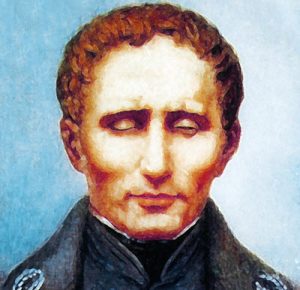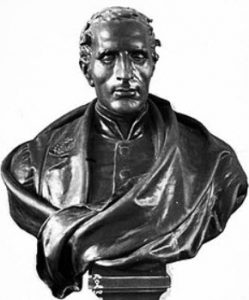Braille was invented by Louis Braille in the 19th century and is named after him.
Contents
About Louis Braille
Louis Braille was born on 4 January, 1809, to Simon-René and Monique Braille, a married couple who owned three hectares of land and vineyards in Coupvray, roughly 20 miles east of Paris. Simon-René was a leatherer and makers of horse tack. Louis had three older siblings; Monique Catherine (b. 1793), Louis-Simon (b. 1795) and Marie Céline (b. 1797).
 As a toddler, young Louis Braille started spending a lot of time in his father’s workshop. At the age of three, Louis accidentally injured one of his eyes with an awl while trying to make a hole in a piece of leather. Louis pressed hard to drive the point through the leather, but the awl glanced across the surface and struck the boy right in the eye. A local physician was consulted, who bound and patched the injured eye, and arranged for the boy to meet a surgeon in Paris the following day. Still, the eye became severely infected, and this disease eventually appeared in the other eye as well (possibly due to sympathetic ophthalmia). By the age of five, Louis Braille was completely blind in both eyes.
As a toddler, young Louis Braille started spending a lot of time in his father’s workshop. At the age of three, Louis accidentally injured one of his eyes with an awl while trying to make a hole in a piece of leather. Louis pressed hard to drive the point through the leather, but the awl glanced across the surface and struck the boy right in the eye. A local physician was consulted, who bound and patched the injured eye, and arranged for the boy to meet a surgeon in Paris the following day. Still, the eye became severely infected, and this disease eventually appeared in the other eye as well (possibly due to sympathetic ophthalmia). By the age of five, Louis Braille was completely blind in both eyes.
His parents went against current trends and encouraged their boy to keep on living a rather normal life despite his blindness. His father hewed canes for him, and Louis learned how to get around not just in his home but in the village as well, and how to navigate the various country paths.
Louis’ ability and eagerness to learn impressed local teachers and priests, who ensured that he became well-educated. At the age of ten, Louis was awarded a scholarship to the Royal Institute for Blind Youth and moved to Paris. It was during his time as a student there that he began developing the system of tactile code that would eventually become braille.
The Haüy system
At the Royal Institute for Blind Youth, Braille and the other pupils were taught how to read using a system called Haüy, which had been created by the school’s founder Valentin Haüy.
Valentine Haüy (who was not blind) manufactured books by embossing heavy paper with raised imprints of Latin letters. His blind pupils would then read the books by tracing their fingers over the text.
Braille learned to read Haüy’s books, but was frustrated over how little information each book contained. Creating the embossed letters was complicated and involved pressing wet paper against copper wire, making it difficult and time consuming to produce even a single page of text and making the books big and cumbersome for small children to use. Also, the complex process prevented the children from learning how to write themselves. (Braille was writing letters home, however, since his father had fashioned him the Latin alphabet in leather letters. Braille would trace their outline when writing.)
Braille origins
As a student at the Royal Institute for Blind Youth, Louis Braille started developing a system that would be more suited to finger-reading than Haüy’s books, and also easier to write.
In 1821, Braille had learned of Captain Charles Barbier’s military cryptography, a system for “night writing” developed in the French Army. This was a code of dots and dashed impressed into thick paper using a slate and stylus. The code could be read by the fingers of soldiers who needed to refrain from talking out loud or lighting a torch.
Inspired by Barbier’s night writing, Braille went on to develop a system of this own. In 1824, when he was fifteen years old, this system was largely completed and ready for use. Instead of using Barbier’s twelve raised dots, Braille reduced the number down to six, and he created uniform columns for each letter. He also made each cell so small that it could be read instantly with the touch of a finger.
In a fascinating twist of fate, Braille would write braille characters using an awl – the same instrument that had blinded him.
Eventually, he designed a en ergonomic interface based on Barbier’s method of using a stale and stylus. With two metal strips soldered across the slate, a secure area was created for the stylus, making it much easier to keep the lines straight.
Musical adaptation
Louis Braille was an avid musician and it’s not surprising to learn that he soon extended braille to include braille musical notation, taking meticulous care to ensure that the musical code would be flexible enough to suit the needs of may different types of musical instruments.
Publications
 Louise Braille first published his writing system in 1829, when he released the book “Method of Writing Words, Music, and Plain Songs by Means of Dots, for Use by the Blind and Arranged for Them”.
Louise Braille first published his writing system in 1829, when he released the book “Method of Writing Words, Music, and Plain Songs by Means of Dots, for Use by the Blind and Arranged for Them”.
A revised version of the book was published in 1837, where Braille had discarded the dashes, relying on dots only. (The dashes had proved to be more difficult to read than the dots.)
Braille’s book “New Method for Representing by Dots the Form of Letters, Maps, Geometric Figures, Musical Symbols, etc., for Use by the Blind” was first published in 1839.
In addition to his books about braille, Louis Braille also wrote the mathematical guide “Little Synopsis of Arithmetic for Beginners” which entered use in 1838.
Later life & Legacy of Louis Braille
After graduating from the Royal Institute for Blind Youth, Louis Braille agreed to stay as a teacher’s aide. In 1833, he was elevated to a full professorship. He would remain at the institute for most of his life, teaching algebra, geometry and history. Braille, who was a skilled cellist and organist, also visited churches all over France to play the organ, and in 1834-1839 he held the position of organist at the Church of Saint-Nicolas-des-Champs in Paris. Later, he would hold a similar position at the Church of Saint-Vincent-de-Paul.
Although Louise Braille was a popular teacher at the institute, the braille system was not taught there during his lifetime. Valentine Haüy had died in 1822, but those in charge of the school remained fiercely dedicated to his methods. The school’s stance against braille was actually so strict that it fired one of its headmasters, Dr. Alexandre Francois-René Pignier, after finding out that he had a history book translated into braille. It would take until 1854 before the institute finally adopted the braille system, at the staunch insistence of its pupils.
By 1854, Louis was already in the grave. Since his late 20s, he had been plagued by the symptoms of a respiratory ailment, perhaps tuberculosis. By the age of 40, it got so bad that he had to stop teaching. He died in 1852, two days after becoming 43 years old.
Today, there is a Braille Museum in Coupvray that includes, among other things, original printed works by Louis Braille.
World Braille Day is celebrated on 4 January each year – Louis Braille’s birthday.